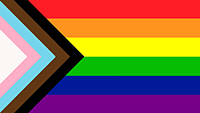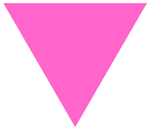The Safe Zones program aims to educate the Winthrop community on issues and concerns
of the LGBTQIA+ community and their allies, while fostering a supportive and accepting
academic and personal atmosphere for all students, faculty, and staff.
Return to Top
The opportunity to interact and learn from others in our diverse community and to make a difference.
This sticker identifies the member as an ally who has resources available.
Return to Top
Participate in a Safe Zones Orientation. For the next orientation date, contact safezones@winthrop.edu.
 The rainbow flag has become the easily-recognized colors of pride for the gay community.
Use of the rainbow flag by the gay community began in 1978 when it first appeared
in the San Francisco Gay and Lesbian Freedom Day Parade.
The rainbow flag has become the easily-recognized colors of pride for the gay community.
Use of the rainbow flag by the gay community began in 1978 when it first appeared
in the San Francisco Gay and Lesbian Freedom Day Parade.
The Victory Over AIDS Flag modifies the rainbow flag by adding a black stripe at the bottom. Suggested by a San Francisco group, the black stripe commemorates those we have lost to AIDS. Sergeant Leonard Matlovich, a much-decorated Vietnam Veteran dying of AIDS, proposed that when a cure is eventually found the black stripes should be removed from all the flags and ceremoniously burned in Washington, D.C.
The Progress Rainbow Flag was designed in 2018 to include new colors emphasizing progress around inclusion. The black and brown stripes are meant to represent people of color. The pink, baby blue, and white are used in the Transgender Pride Flag.

The pink triangle is easily one of the more popular and widely recognized symbols for the gay community. The pink triangle is rooted in World War II times and reminds us of the tragedies of that era. Although homosexuals were only one of the many groups targeted for extermination by the Nazi regime, it is unfortunately the group that history often excludes. In the 1970s, gay liberation groups resurrected the pink triangle as a popular symbol for the gay rights movement. Not only is the symbol easily recognized, but it draws attention to oppression and persecution then and now. In the 1980s, ACT-UP (AIDS Coalition To Uneash Power) began using the pink triangle for their cause. They inverted the symbol, making it point up, to signify an active fight back rather than a passive resignation to fate.
Many people understand the term bisexual to refer to someone who is attracted to men and women. Some argue that this reinforces a gender binary and use the word pansexual to refer to individuals who are attracted to people regardless of sex or gender. This is not the only way the terms are used though.
For more information on how the word bisexual and pansexual can be used in the same way, watch this video.
Pronouns are important because their correct or incorrect use can validate or invalidate someone's identity. To use someone's pronouns correctly shows them that you respect their identity and have made an effort to make them feel welcome. Watch this video to hear what people have to say about the importance of pronouns.
To speak out against violence or harassment, respect all people, to listen, and to supply resources to students.
It is a personal choice to display a sticker. There are many reasons why someone might not display the sticker. Some people will not support the project. Some people will, but choose not to display the sticker. All are welcome to attend the orientation, regardless.
This is something that does not happen often. However, if it should happen, understand that the student is entrusting you with something very personal. Listen and refer them to contact us and to the list of resources.
Students may be more at ease and censor themselves less in your office, allowing for a more genuine exchange. Students may not act differently, but will feel more welcome.
Wherever you feel most comfortable. Most members choose their office door or desk.
Return to Top